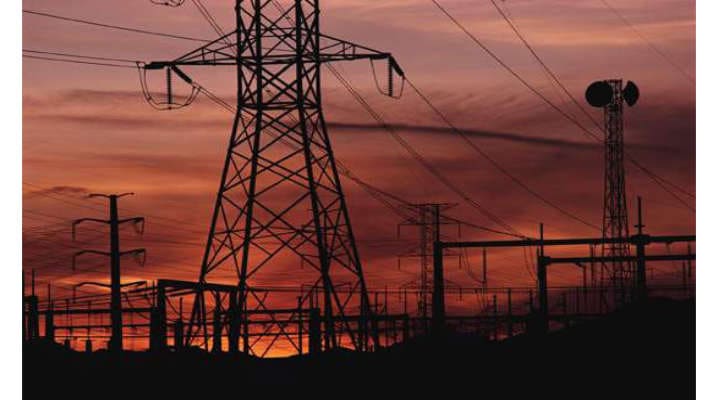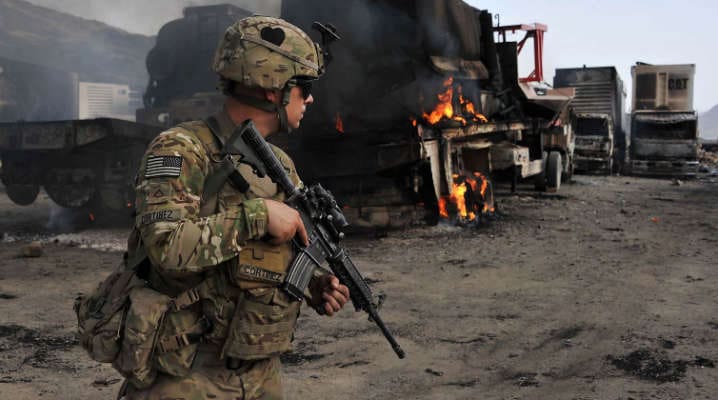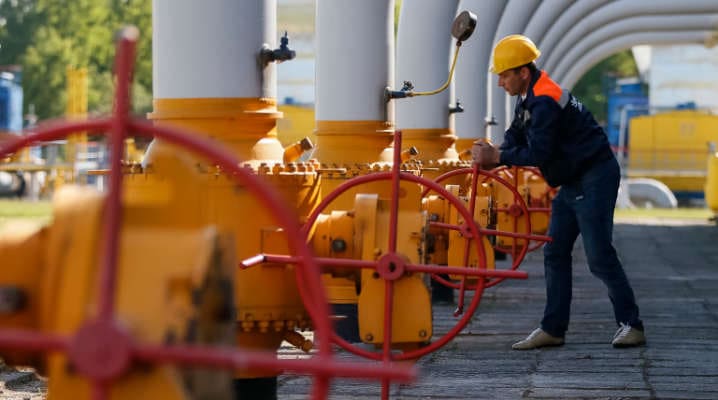Energy security plays an important role in our common security.

The disruption of energy supply could affect the security and resilience of societies. Assuring supplies and protecting critical infrastructure is of increasing importance in the current security environment. © NATO
Ten years ago, at their 2008 Summit in Bucharest, NATO Allies agreed their first report on NATO’s role in energy security. Negotiating this confidential paper, which listed major principles as well as key areas of engagement, was challenging.
No one doubted that energy developments could have major security implications for Allies and the Alliance. After all, in particular for some of NATO’s new members that were burdened with serious energy vulnerabilities, energy security was a question of national security. However, given that NATO was not an energy institution, Allies struggled to define NATO’s role in an area that was largely non-military in nature, featured many institutional players and, above all, remained mostly a national responsibility. Accordingly, the Allies defined a broad political framework, yet without suggesting a concrete energy security agenda for the Alliance.
Today, a decade later, the caution that characterised NATO’s initial steps in energy security has given way to a more confident approach. Major changes in the international security environment and energy landscape have brought increased strategic attention to the issue, resulting in a pragmatic energy security agenda that provides tangible value for Allies and partner countries.
How has this change come about?
Global energy developments
The most important driver for NATO’s energy agenda has been the evolution of the global energy landscape. Russia has continued to use energy as part of its foreign policy and, in the case of Ukraine, also demonstrated that energy is part of Moscow’s hybrid warfare toolbox.
Cyber threats have been growing, with the energy sector a major target.
Attacks on NATO fuel convoys in Afghanistan have highlighted the importance of assuring energy supplies to military operations.
Terrorist attacks against energy infrastructure, notably in Northern Africa and the Middle East, have continued, with an average of about 350 incidents per year.
Piracy has remained a threat to tankers carrying oil from the Gulf region through the Indian Ocean – a challenge that NATO’s counter-piracy operation Ocean Shield helped to address.
Other threats to energy infrastructure have been posed by disasters, such as the 2010 Pakistan floods and the Fukushima nuclear accident in 2011.
Finally, the rise of “unconventionals” – such as shale oil and gas – has revolutionised the global energy landscape, with potentially massive ramifications for traditional producers.

Attacks on NATO fuel convoys in Afghanistan highlighted the importance of assuring energy supplies to military operations. © USA Today
A coherent agenda
With all these developments bringing home the close link between energy and security, NATO has had its work cut out for it. While the classified Bucharest report remained the overarching guideline for NATO’s role in energy security, the 2010 Strategic Concept, as well as the Progress Reports presented to NATO Heads of State and Government at each NATO Summit, have provided additional guidance and also sketched out a way ahead. This has allowed NATO to develop an unclassified energy security narrative that it could also promote publicly.
To simplify an otherwise complex story, NATO has divided its role into three areas:
- Raising awareness includes intelligence-sharing on energy development, political consultations among Allies, as well as among Allies and partners, and exchanges with outside experts.
- Supporting the protection of critical energy infrastructure is mainly about sharing best practices among experts, organising training courses, and inserting energy-related scenarios into exercises.
- Enhancing energy efficiency in the military includes the sharing of national best practices, demonstrations of energy-efficient equipment, and the development of military energy efficiency standards.
Building a stakeholder community
To better define NATO’s role in energy security and to avoid duplicating the work of others, it has been important to reach out to other energy players. NATO has established working-level contacts with the International Energy Agency (IEA), the Directorate-General for Energy of the European Commission, and experts from academia and the private sector. To enhance energy efficiency in the military, the stakeholder community has also included military engineers and defence companies. This outreach, along with enhanced public diplomacy activities, has made NATO’s role in energy security both clearer and more widely known.
The accreditation of the NATO Energy Security Centre of Excellence (COE) in Lithuania in 2012 brought another powerful player into the equation. The COE, which has meanwhile expanded to include 11 member nations, provides analysis and training across the entire spectrum of NATO’s energy security agenda and serves as a unique asset for supporting and promoting NATO’s energy security agenda.
NATO’s two Strategic Commands have also become interested in the issue, contributing with expertise as well as with support on education and training.
Reaching the strategic level
Another major goal was reached in 2014, when the North Atlantic Council (NAC) held an informal meeting with energy experts. These discussions, featuring representatives of the IEA, the European Commission and the US State Department, turned out to be so insightful that Allies decided to turn the “Energy NAC” into an annual event. Energy security had arrived at the strategic level.
A year later the first Energy Security Strategic Awareness Course took place at the NATO School in Oberammergau. With participants from over 20 Allies and partner countries, the course covered a broad spectrum of energy challenges, ranging from the geopolitics of oil and gas to enhancing the energy efficiency of armed forces. Supported by NATO’s Strategic Commands, the COE and the Naval Postgraduate School in Monterey, California, it has now become an annual event and a model for courses elsewhere.
Enhancing partnerships
NATO’s evolving role in energy security has attracted the interest of several partner countries, notably energy producers such as Azerbaijan and Algeria and transit countries such as Georgia and Ukraine.
Consequently, NATO has organised various expert workshops on, for example, exchanging best practices on the protection of critical energy infrastructure, often with the support of the NATO Science for Peace and Security Programme.
In February 2018, NATO held its first energy security course at the newly created NATO-Istanbul Cooperation Initiative Regional Cooperation Centre in Kuwait. And several partner countries, notably Ukraine, briefed Allies on their respective energy situation.
Hybrid war and collective defence
Russia’s illegal annexation of Crimea in 2014 and its low-level war against Ukraine have added an important new dimension to NATO’s energy agenda: the linkage between energy and hybrid warfare. To destabilise Ukraine, Russia had increased the gas price, supported separatists with energy deliveries and expropriated Ukrainian energy assets in and around Crimea. To support Ukraine, the Energy Security COE and various other players held a major table-top exercise in Kyiv in October 2017, centred on protecting the country’s electrical grid against cyber attacks.

Over the years, Moscow has used energy as one of its tools to destabilise Ukraine. In June 2014, following its illegal annexation of Crimea and its sponsorship of separatists in Eastern Ukraine, Russia threatened to cut off gas supplies if Kiev failed to pay in advance, warning that this could also affect supplies to European consumer nations via Ukraine. © Reuters
As NATO has refocused its efforts on bolstering the collective defence of its eastern member states, the energy question has posed itself in yet another light: meeting the energy challenges of a military strategy that relies on major reinforcements. To come to grips with this new challenge, military energy requirements have been analysed, and NATO has started to integrate energy considerations into some of its exercises.
The “smart energy” agenda, which aims to enhance energy efficiency in the military, has also made progress: energy-related questions have been inserted into the NATO Defence Planning Process, as a prerequisite for setting interoperability standards. Moreover, the Energy Security COE hosts a biennial event to explore “Innovative Energy Solutions for Military Application”.
The way ahead
The years ahead will see an even stronger focus on education and training, notably with partner countries. More energy-related scenarios will be inserted into NATO exercises, and table-top exercises with Allies and partners are likely to increase in number as well as complexity.
A particular new focus of NATO’s energy-related work will be enhancing the resilience of Allies. Since resilient energy supplies are vital for collective defence, NATO support for Allies in this area is likely to increase. It is also fair to assume that addressing cyber threats to energy infrastructure will gain in importance. While the protection of energy infrastructure remains a national responsibility, NATO’s education and training establishments offer many opportunities – for Allies and partners alike – to get a firm grasp on these challenges.
NATO’s relations with other actors, from the IEA to the private energy sector, will also deepen, allowing NATO to benefit from outside expertise. The number of briefings to the NAC by outside experts is also likely to increase.
Finally, there is a need for more regular consultations among Allies on energy security developments and their security implications. The Brussels Summit Declaration states: “… it is essential to ensure that the members of the Alliance are not vulnerable to political or coercive manipulation of energy, which constitutes a potential threat”. Given Russia’s use of energy as part of its hybrid threats towards Ukraine, it would seem that NATO Allies, many of which are customers of Russian gas and oil, might have a lot to discuss.
